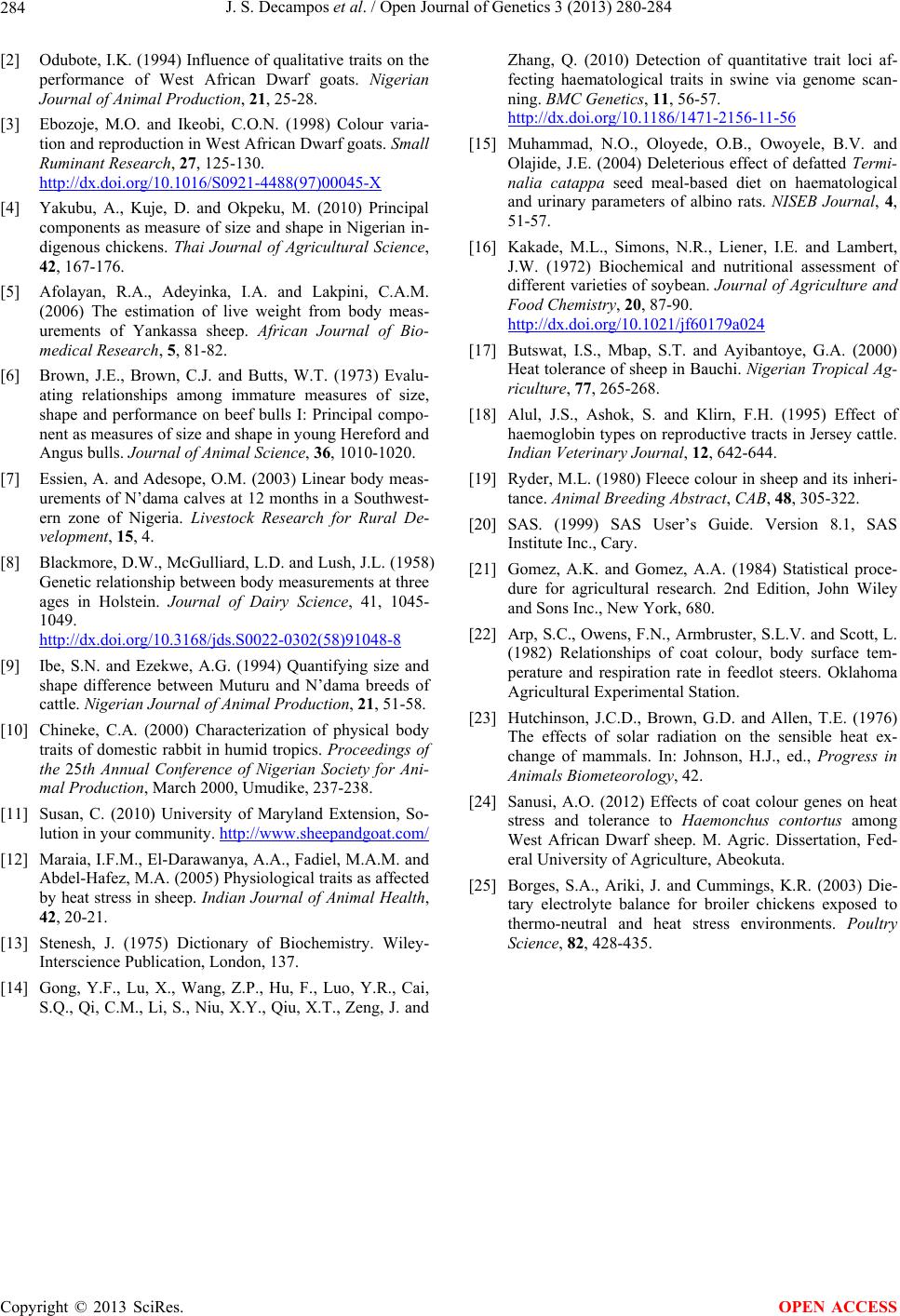
J. S. Decampos et al. / Open Journal of Genetics 3 (2013) 280-284
284
[2] Odubote, I.K. (1994) Influence of qualitative traits on the
performance of West African Dwarf goats. Nigerian
Journal of Animal Production, 21, 25-28.
[3] Ebozoje, M.O. and Ikeobi, C.O.N. (1998) Colour varia-
tion and reproduction in West African Dwarf goats. Small
Ruminant Research, 27, 125-130.
http://dx.doi.org/10.1016/S0921-4488(97)00045-X
[4] Yakubu, A., Kuje, D. and Okpeku, M. (2010) Principal
components as measure of size and shape in Nigerian in-
digenous chickens. Thai Journal of Agricultural Science,
42, 167-176.
[5] Afolayan, R.A., Adeyinka, I.A. and Lakpini, C.A.M.
(2006) The estimation of live weight from body meas-
urements of Yankassa sheep. African Journal of Bio-
medical Research, 5, 81-82.
[6] Brown, J.E., Brown, C.J. and Butts, W.T. (1973) Evalu-
ating relationships among immature measures of size,
shape and performance on beef bulls I: Principal compo-
nent as measures of size and shape in young Hereford and
Angus bulls. Journal of Animal Science, 36, 1010-1020.
[7] Essien, A. and Adesope, O.M. (2003) Linear body meas-
urements of N’dama calves at 12 months in a Southwest-
ern zone of Nigeria. Livestock Research for Rural De-
velopment, 15, 4.
[8] Blackmore, D.W., McGulliard, L.D. and Lush, J.L. (1958)
Genetic relationship between body measurements at three
ages in Holstein. Journal of Dairy Science, 41, 1045-
1049.
http://dx.doi.org/10.3168/jds.S0022-0302(58)91048-8
[9] Ibe, S.N. and Ezekwe, A.G. (1994) Quantifying size and
shape difference between Muturu and N’dama breeds of
cattle. Nigerian Journal of Animal Production, 21, 51-58.
[10] Chineke, C.A. (2000) Characterization of physical body
traits of domestic rabbit in humid tropics. Proceedings of
the 25th Annual Conference of Nigerian Society for Ani-
mal Production, March 2000, Umudike, 237-238.
[11] Susan, C. (2010) University of Maryland Extension, So-
lution in your community. http://www.sheepandgoat.com/
[12] Maraia, I.F.M., El-Darawanya, A.A., Fadiel, M.A.M. and
Abdel-Hafez, M.A. (2005) Physiological traits as affected
by heat stress in sheep. Indian Journal of Animal Health,
42, 20-21.
[13] Stenesh, J. (1975) Dictionary of Biochemistry. Wiley-
Interscience Publication, London, 137.
[14] Gong, Y.F., Lu, X., Wang, Z.P., Hu, F., Luo, Y.R., Cai,
S.Q., Qi, C.M., Li, S., Niu, X.Y., Qiu, X.T., Zeng, J. and
Zhang, Q. (2010) Detection of quantitative trait loci af-
fecting haematological traits in swine via genome scan-
ning. BMC Genetics, 11, 56-57.
http://dx.doi.org/10.1186/1471-2156-11-56
[15] Muhammad, N.O., Oloyede, O.B., Owoyele, B.V. and
Olajide, J.E. (2004) Deleterious effect of defatted Termi-
nalia catappa seed meal-based diet on haematological
and urinary parameters of albino rats. NISEB Journal, 4,
51-57.
[16] Kakade, M.L., Simons, N.R., Liener, I.E. and Lambert,
J.W. (1972) Biochemical and nutritional assessment of
different varieties of soybean. Journal of Agriculture and
Food Chemistry, 20, 87-90.
http://dx.doi.org/10.1021/jf60179a024
[17] Butswat, I.S., Mbap, S.T. and Ayibantoye, G.A. (2000)
Heat to lerance of shee p in Bauchi. Nigerian Tropical Ag-
riculture, 77, 265-268.
[18] Alul, J.S., Ashok, S. and Klirn, F.H. (1995) Effect of
haemoglobin types on reproductive tracts in Jersey cattle.
Indian Veterinary Journal, 12, 642-644.
[19] Ryder, M.L. (1980) Fleece colour in sheep and its inheri-
tance. Animal Breeding Abstract, CAB, 48, 305-322.
[20] SAS. (1999) SAS User’s Guide. Version 8.1, SAS
Institute Inc., Cary.
[21] Gomez, A.K. and Gomez, A.A. (1984) Statistical proce-
dure for agricultural research. 2nd Edition, John Wiley
and Sons Inc., New York, 680.
[22] Arp, S.C., Owens, F.N. , Armbruster, S.L.V. and Scott, L.
(1982) Relationships of coat colour, body surface tem-
perature and respiration rate in feedlot steers. Oklahoma
Agricultural Experimental Station.
[23] Hutchinson, J.C.D., Brown, G.D. and Allen, T.E. (1976)
The effects of solar radiation on the sensible heat ex-
change of mammals. In: Johnson, H.J., ed., Progress in
Animals Biometeorology, 42.
[24] Sanusi, A.O. (2012) Effects of coat colour genes on heat
stress and tolerance to Haemonchus contortus among
West African Dwarf sheep. M. Agric. Dissertation, Fed-
eral University of Agriculture, Abeokuta.
[25] Borges, S.A., Ariki, J. and Cummings, K.R. (2003) Die-
tary electrolyte balance for broiler chickens exposed to
thermo-neutral and heat stress environments. Poultry
Science, 82, 428-435.
Copyright © 2013 SciRes. OPEN ACCESS